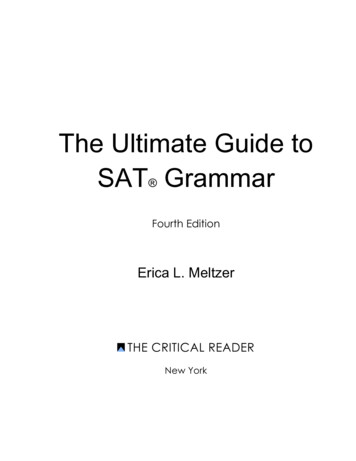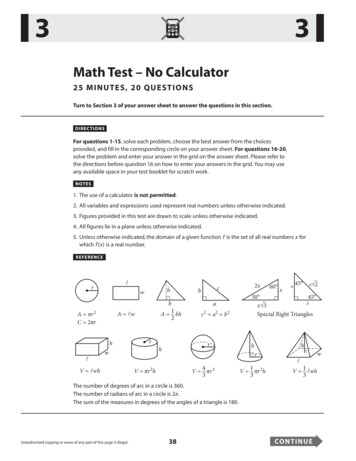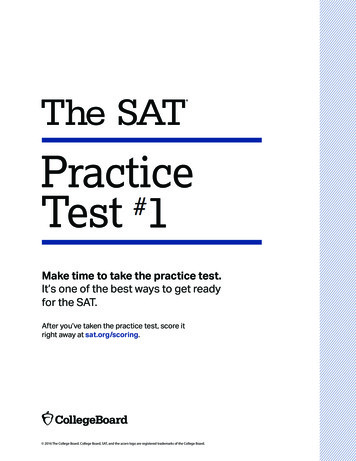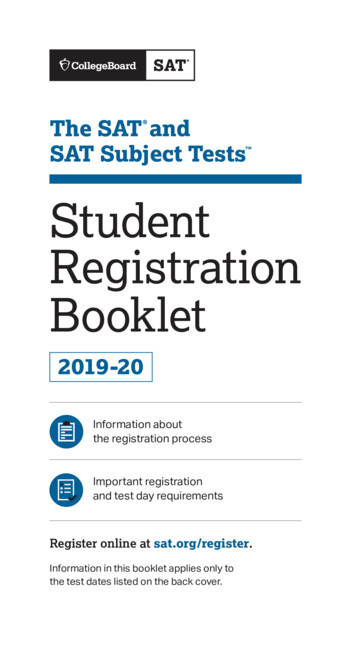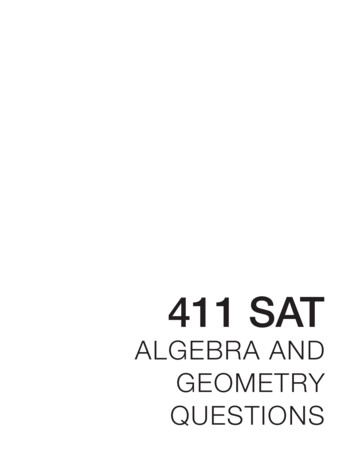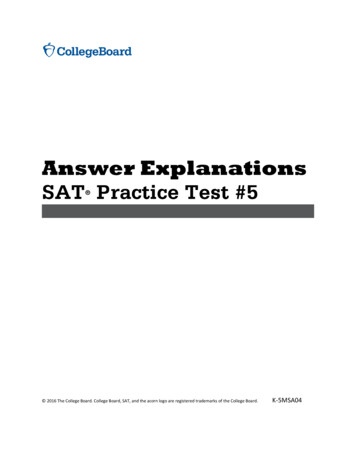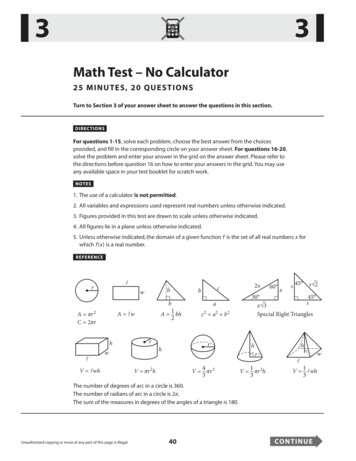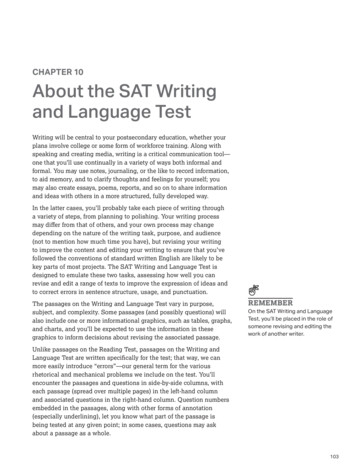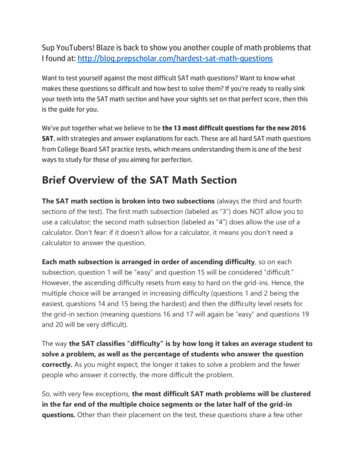
Transcription
Sup YouTubers! Blaze is back to show you another couple of math problems thatI found at: ionsWant to test yourself against the most difficult SAT math questions? Want to know whatmakes these questions so difficult and how best to solve them? If you’re ready to really sinkyour teeth into the SAT math section and have your sights set on that perfect score, then thisis the guide for you.We’ve put together what we believe to be the 13 most difficult questions for the new 2016SAT, with strategies and answer explanations for each. These are all hard SAT math questionsfrom College Board SAT practice tests, which means understanding them is one of the bestways to study for those of you aiming for perfection.Brief Overview of the SAT Math SectionThe SAT math section is broken into two subsections (always the third and fourthsections of the test). The first math subsection (labeled as “3”) does NOT allow you touse a calculator; the second math subsection (labeled as “4”) does allow the use of acalculator. Don’t fear: if it doesn’t allow for a calculator, it means you don’t need acalculator to answer the question.Each math subsection is arranged in order of ascending difficulty, so on eachsubsection, question 1 will be “easy” and question 15 will be considered “difficult.”However, the ascending difficulty resets from easy to hard on the grid-ins. Hence, themultiple choice will be arranged in increasing difficulty (questions 1 and 2 being theeasiest, questions 14 and 15 being the hardest) and then the difficulty level resets forthe grid-in section (meaning questions 16 and 17 will again be “easy” and questions 19and 20 will be very difficult).The way the SAT classifies “difficulty” is by how long it takes an average student tosolve a problem, as well as the percentage of students who answer the questioncorrectly. As you might expect, the longer it takes to solve a problem and the fewerpeople who answer it correctly, the more difficult the problem.So, with very few exceptions, the most difficult SAT math problems will be clusteredin the far end of the multiple choice segments or the later half of the grid-inquestions. Other than their placement on the test, these questions share a few other
commonalities. Let us look at what these types of questions have in common, then lookat example questions and how to solve them.But First, Should You Be Focusing on the Hardest MathQuestions Right Now?If you’re just getting started in your study prep (or if you’ve simply skipped thisfirst, crucial step), definitely stop and take a full practice test to gauge yourcurrent scoring level. Check out our guide to all the free SAT practice tests availableonline and then sit down to take a test all at once. The absolute best way to assess yourcurrent level is to simply take the SAT practice test as if it were real, keeping strict timingand working straight through with only the allowed breaks (we know--probably notyour favorite way to spend a Saturday).Once you’ve got a good idea of your current level and percentile ranking, you can setmilestones and goals for your ultimate score. If you’re currently scoring in the 200400 range on the Math section or the 400-600 range, your best bet is first to checkout our guides to improving your math score to where you want it to be before youstart in trying to tackle the most difficult math problems on the test.If, however, you're already scoring above a 600 on the Math section and want totest your mettle for the real SAT, then definitely proceed to the rest of this guide.If you’re aiming for perfect (or close to), then you’ll need to know what the most difficultSAT math questions look like and how to solve them. And luckily, that’s exactly whatwe’ll do.WARNING: since there are a limited number of official SAT practice tests, you may wantto wait to read this article until you've attempted all or most of the first four officialpractice tests (since the questions below were taken from those tests). If you're worriedabout spoiling those tests, stop reading this guide now; come back and read it whenyou've completed them.The 13 Hardest SAT Math QuestionsNo Calculator Questions
Question 1ANSWER EXPLANATION: If you think ofthe equation as an equation for a liney mx bwhereC 5/9 (F-32)orC (5/9) F (5/9) 32you can see the slope of the graphis 5/9, which means that for anincrease of 1 degree Fahrenheit,the increase is 5/9 of 1 degreeCelsius. Therefore, statement I istrue. This is the equivalent tosaying that an increase of 1 degreeCelsius is equal to an increase of9/5 degrees Fahrenheit. Since 9/5 1.8, statement II is true. On theother hand, statement III is nottrue, since a temperature increaseof 9/5 degrees Fahrenheit, not 5/9degree Fahrenheit, is equal to atemperature increase of 1 degreeCelsius. The final answer is D.Question 2ANSWER EXPLANATION: There aretwo ways to solve this question. Thefaster way is to multiply each side ofthe given equation by ax 2 (so youcan get rid of the fraction). When youmultiply each side by ax 2, youshould have:24x2 25x 47 ( 8x 3)(ax 2) 53You should then multiply ( 8x 3) and (ax 2) using FOIL.24x2 25x 47 8ax2 3ax 16x 6 53Then, reduce on the right side of the equation
24x2 25x 47 8ax2 3ax 16x 47Since the coefficients of the x2-term have to be equal on both sides of the equation, 8a 24, or a 3.The other option which is longerand more tedious is to attemptto plug in all of the answerchoices for a and see whichanswer choice makes both sidesof the equation equal. Again, thisis the longer option, and I do notrecommend it for the actual SATas it will waste too much time.The final answer is B.Question 3ANSWER EXPLANATION: One approach is to express8x/2yso that the numerator and denominator are expressed with the same base. Since 2 and 8are both powers of 2, substituting 23 for 8 in the numerator of 8x/2y gives(23)x/2ywhich can be rewritten23x/2ySince the numerator and denominator of have a common base, this expression can berewritten as 2(3x y). In the question, it states that 3x y 12, so one can substitute 12 for theexponent, 3x y, giving that the8x/2y 212The final answer is A.
Question 4ANSWER EXPLANATION:To rewrite 8 i/3 2i in thestandard form a bi, you needto multiply the numerator anddenominator of 8 i/3 2i bythe conjugate, 3 2i. Thisequals(8 i/3 2i) (3 2i/3 2i) 24 16i 3 ( i)(2i) / (32) (2i)2Since i2 1, this last fractioncan be reduced simplified to24 16i 3i 2 /9 ( 4) 26 13i /13which simplifies further to 2 i.Therefore, when 8 i/3 2i isrewritten in the standard forma bi, the value of a is 2. Thefinal answer is A.Question 5ANSWER EXPLANATION: TriangleABC is a right triangle with itsright angle at B. Therefore, AC isthe hypotenuse of right triangleABC, and AB and BC are the legsof right triangle ABC. According tothe Pythagorean theorem,AB 202 162 400 256 144 12Since triangle DEF is similar to triangle ABC, with vertex F corresponding to vertex C, themeasure of angle F equals the measure of angle C. Therefore, sinF sinC. From the sidelengths of triangle ABC,
sinF Opposite side/ hypotenuse AB/AC 12/20 3/5Therefore, sinF 3/5. The final answer is 3/5 or 0.6.Calculator QuestionsQuestion 6ANSWER EXPLANATION: Inorder to solve this problem,you should create twoequations using twovariables (x and y) and theinformation you’re given. Letx be the number of lefthanded female students andlet y be the number of lefthanded male students. Usingthe information given in theproblem, the number of righthanded female students willbe 5x and the number ofright-handed male studentswill be 9y. Since the totalnumber of left-handedstudents is 18 and the totalnumber of right-handedstudents is 122, the systemof equations below must betrue:x y 185x 9y 122When you solve this systemof equations, you get x 10 and y 8. Thus, 50 of the 122 right-handed students are female.Therefore, the probability that a right-handed student selected at random is female is50/122, which to the nearest thousandth is 0.410. The final answer is A.Questions 7 & 8Use the following information for both question 7 and question 8.
Question 7ANSWEREXPLANATION: Since thequestion states thatLittle’s law can beapplied to any single partof the store (for example,just the checkout line,then the average numberof shoppers, N, in thecheckout line at any timeis N rt, where r is thenumber of shoppers entering the checkout line per minute and T is the average number ofminutes each shopper spends in the checkout line. Since 84 shoppers per hour make apurchase, 84 shoppers per hour enter the checkout line. However, this needs to beconverted to the number of shoppers per minute (in order to be used with t 5). Since thereare 60 minutes in one hour, the rate is 84 shoppers per hour/ 60 minutes 1.4 shoppersper minute. Using the given formula with r 1.4 and t 5 yieldsN rt (1.4)(5 ) 7Therefore, the average number of shoppers, N, in the checkout line at any time duringbusiness hours is 7. The final answer is 7.
Question 8ANSWER EXPLANATION: Accordingto the original information given,the estimated average number ofshoppers in the original store at anytime is 45. In the question, it statesthat, in the new store, the managerestimates that an average of 90shoppers per hour enter the store,which is equivalent to 1.5 shoppersper minute. The manager alsoestimates that each shopper staysin the store for an average of 12minutes. Thus, by Little’s law, there are, on average, N rt (1.5)(12) 18 shoppers in thenew store at any time. This is(45 18/45) x100 60percent less than the average number of shoppers in the original store at any time. Thefinal answer is 60.Question 9ANSWER EXPLANATION: Thevolume of the grain silo can befound by adding the volumes ofall the solids of which it iscomposed (a cylinder and twocones). The silo is made up of acylinder (with height 10 feetand base radius 5 feet) and twocones (each with height 5 ftand base radius 5 ft). Theformulas given at the beginningof the SAT Math section:Volume of a ConeV 1/3πr2hVolume of a CylinderV πr2hcan be used to determine thetotal volume of the silo. Since
the two cones have identical dimensions, the total volume, in cubic feet, of the silo is givenbyVsilo π(52)(10) (2)(1/3)π(52)(5) (4/3)(250)πwhich is approximately equal to 1,047.2 cubic feet. The final answer is D.Question 10ANSWER EXPLANATION:Since the average (arithmeticmean) of 2 numbers is equalto the sum of the 2 numbersdivided by 2, the equations x m 9/2, y 2m 15/2, z 3m 18/2 are true. Theaverage of x, y, and z is givenby x y z/3. Substituting theexpressions in m for eachvariable (x, y, z) gives[(m 9/2) (2m 15/2) (3m 18/2)]/3This fraction can be simplified to m 7. The final answer is B.Question 11ANSWER EXPLANATION: Theequation f(x) k gives thesolutions to the system ofequationsy f(x) x3 x2 x 11/4andy kA real solution of a system oftwo equations corresponds to apoint of intersection of thegraphs of the two equations inthe xy-plane. The graph of y k isa horizontal line that containsthe point (0,k), and the line withequation y 3 is a horizontalline that intersects the graph of
the cubic equation three times. Therefore, the equation f(x) 3 has three real solutions.The final answer is D.Question 12ANSWER EXPLANATION: Tosolve this problem, you need toset up to equations withvariables. Let q1 be the dynamicpressure of the slower fluidmoving with velocity v1, andlet q2 be the dynamic pressureof the faster fluid moving withvelocity v2. ThenV2 1.5v1Given the equation q 1/2nv2, substituting the dynamic pressure and velocity of the fasterfluid gives q2 1/2n(v2)2. Since v2 1.5v1, the expression 1.5v1 can be substituted for v2 inthis equation, giving q2 1/2n(1.5v1)2. By squaring 1.5, you can rewrite the previousequation asQ2 (2.25)(1/2)n(v1)2 (2.25)q1Therefore, the ratio of the dynamic pressure of the faster fluid isq2/q1 2.25q1/q1 2.25The final answer is 2.25 or 9/4.Question 13ANSWER EXPLANATION: Ifthe polynomial p(x) isdivided by x 3, the resultcan be written asp(x)/x-3 q(x) (r/x-3)where q(x) is a polynomialand r is the remainder.Since x 3 is a degree 1polynomial, the remainderis a real number. Therefore,
p(x) can be rewritten as p(x) (x 3)q(x) r, where r is a real number. In the question itsaid that p(3) 2 so it must be true that 2 p(3) (3 3)q(3) r (0)q(3) r rTherefore, the remainder when p(x) is divided by x 3 is 2. The final answer is D.I hope I helped all of you who wanted to learn something new orstudy for your next math test. Enjoy this amazing math!
These are all hard SAT math questions from College Board SAT practice tests, which means understanding them is one of the best ways to study for those of you aiming for perfection. Brief Overview of the SAT Math Section The SAT math section is broken into two subsections (always the

